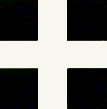

Fiat CR.42 from the Hungarian Air Force's Arrow squadron (with late squadron insignia).


Fiat CR.42 from the Hungarian Air Force's Arrow squadron (with late squadron insignia).
The first foreign customer of the CR.42 was the Magyar Királyi Honvéd Légierö (MKHL - Royal Hungary Air Arm), which placed orders for 18 aircraft during the summer of 1938. The Hungarians were aware that the CR.42 was conceptually outdated, but considered the rapid re-equipment of their fighter component vital and the Italian government had expressed its willingness to forgo delivery positions in order to expedite the re-equipment of Hungarian units.
Between 16 June and 20 November 1939, the CR.42s arrived in Hungary and 1. vadász ezred (1st Fighter Regiment) began conversion from the Fiat CR.32. First squadron equipped with the fighter was 1/3. ‘Kőr ász’ vadászszázad (‘Heart of Ace’ squadron), which also suffered the first fatal accident when szakaszvezető Béla Simon crashed at Mátyásföld with V.207 on 4 October 1939.
In November 1939, Hungary ordered an additional 50 CR.42s from Italy, which arrived between 10 February and 30 June 1940. 1. vadász ezred’s two two-squadron component groups, the 1./I osztály (Fighter Group) at Mátyásföld (later to Kolozsvár-Szamosfalva where it was renumbered to 2/II. osztály) and the 1./II osztály at Mátyásföld, Budapest, had received their full complement of fighters by the late spring of 1940. In 1942, the Hungarians and the Italians bartered a captured Yugoslavian S.79 against two more CR.42s, thus MKHL used a total of 70 CR 42.
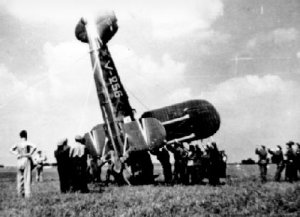
April 1941
Hungary used their new fighter for the first time during the Yugoslavian campaign in April 1941, they flew a number of sweeps into Yugoslav airspace during the assault. However, some concern was expressed when it was discovered that the CR.42s were incapable of intercepting the Yugoslav Blenheims that attacked Pécs and Szeged.
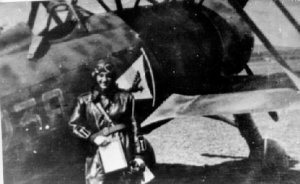
June 1941
Nevertheless when a special Air Force Brigade was formed less than two months later to accompany the Hungarian Fast Corps that was to participate in the assault on the Soviet Union to be launched in June (Hungary declared war on Soviet Union on 27 June), the principal fighter element was provided by the 12 CR.42s of the 1/3. ‘Kőr ász’ vadászszázad of the 1./II osztály.
27 June 1941
At around 08:00, the MKHL made its first air attack against Soviet targets, when around 30 bombers comprising Junkers Ju 86s of 4/3. and 4/4. bombázószázad (Bomber Squadron) and one squadron of Caproni Ca.135s of 3/5. bombázószázad attacked targets in Stanislav (now Ivano-Frankovsk). They were escorted by 9 CR 42s of the 2/3. ‘Ricsi’ vadászszázad of the 2./II osztály led by százados vitéz Aladár Szobránczy. After the bombers had done their work, the escorting fighters strafed targets of opportunity in the area. Őrmester (Sergeant) Arpád Kertész was lost in dense clouds and when he finally broke through, he sighted a reconnaissance machine. When he flew towards it, it opened fire so he identified it as a Russian reconnaissance aircraft (probably a Polikarpov R-5). After a short exchange of fire, the reconnaissance aircraft burst into flames. He turned back towards his base flying on his instruments but after a while, his fuel ran low and he decided to land. Fortunately, when he landed he found himself among Rumanians. However, it took him more than a week to squeeze some petrol out of them. At last, they gave him some but it was still so little that he had to return to his unit via his pre-war base in Hungary.
During the same mission, the fighter squadron lost CR 42 V.217, when zászlós László Kázár was shot down by antiaircraft fire. He made a forced landing and after setting fire to his personal mount for two years, he managed to return after 16 days spent hiding behind enemy lines, with the help of local Ukrainian anti-Communist guerrillas.
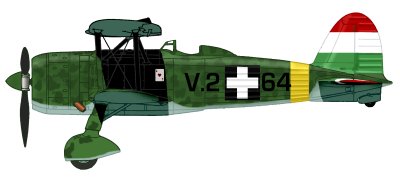
29 June 1941
Despite poor weather conditions over the sub-Carpathian region on 29 June, Hungarian aircraft did undertake several combat missions. 25 Ju 86 K-2 and Ca.135bis bombers, escorted by Fiat CR.42s, targeted Striy. This was the last action of a two-day strategic bombing offensive against Soviet rear area targets, in retaliation of the bombing of Kassa. While returning from the mission, Fiat CR.42 V.245, of the 2/3. ‘Ricsi’ vadászszázad, flown by főhadnagy László Pottyondy force-landed overturning his aircraft. The aircraft was 50% damaged, but the pilot escaped uninjured.
1 July 1941
During the evening, 18 Hungarian Ju86Ks of the 4/4. bombázószázad accompanied by nine Ca.135s of 3/5. bombázószázad, escorted by two squadrons of CR.42s, bombed Delatin railway station and Soviet troop concentrations beyond the front line.
8 July 1941
The 2/3. vadászszázad moved from their Hungarian advanced base at Bustyaháza to a captured Russian airfield some 8km from of Kolomea.
On the same day, the 2/4. ‘Nyil vadászszázad of the 2./II vadászosztály suffered the loss of a whole section when three CR.42s (V.253, V.254 and V.255) crashed due to bad weather encountered over the Carpathian Mountains. The section leader, hadnagy Pál Irányi’s aircraft hit a tree, but he recovered and eventually became an ace pilot. One of his men, szakaszvezetö Antal Nébli (V.253) hit the ground violently north-east of Dora and was killed instantly. The third pilot, szakaszvezetö Endre Bajcsy baled out of his doomed aircraft and broke his hip when he came down in rough terrain.
10 July 1941
The Hungarian közelfelderítö-század (with nine Heinkel He46s) and the 2/3. "Ricsi" vadászszázad (with nine CR.42s) moved to Yezierzany landing ground.
11 July 1941
Hadnagy Gyözö Vámos’ section from 2/3. ‘Ricsi’ vadászszázad provided air cover for advancing units of the Hungarian Fast Corps. There were no enemy aircraft in the air but, not wishing to return without firing their guns, the three Fiats attacked and dispersed a retreating Soviet column in the Smotricz area. Almost immediately, five Soviet I-16s appeared and, in the ensuing dogfight, the section shot one down and severely damaged another and sent the other three fleeing eastward.
Hadapród őrmester Béla Dikó of 2/3. vadászszázad somersaulted Fiat CR. 42 V.257 at Stanislav and he was injured. He ended up in hospital at Stanislav while his aircraft needed extensive repair.
12 July 1941
During the day, alezredes (Lieutenant Colonel) Béla Orosz, commander of the air contingent attached to the Fast corps, ordered százados Aladár Szobránczy, commander of 2/3. vadászszázad, to provide escort for two short-range reconnaissance squadrons, which were to bomb an enemy transport assembly point west of Zwanczyk. Szobránczy, főhadnagy László Pottyondy, hadnagy Gyözö Vámos (CR.42 V.265), szakaszvezetö Péter Soós and szakaszvezetö János Balogh took off at 10:00 and soon joined the formation of WM 21 Sólyom aircraft of the VIIth and Xth közelfelderítö-század. On the way to the target, Szobránczy caught sight of three twin-engined Soviet bombers. As the Fiats dived on them, seven Soviet I-16s appeared suddenly and engaged the Hungarian biplanes. Szobránczy selected a Soviet fighter and soon saw his tracers penetrating the cockpit. The machine began to trail thick smoke and hit the ground west of Zvanchyk. Pottyondy also attacked an I-16 but, at the same time, he was jumped by another I-16. He noticed with satisfaction that Soós took over his victim-to-be and he was able to concentrate on his attacker. Despite the Soviet machine’s advantage of altitude, thanks to the superb manoeuvrability of the CR.42, Pottyondy managed to get behind the Russian and his bullets tore pieces of the fuselage. The Russian pilot steadied his plane only to fly into the machine gun fire of the oncoming Vámos. The two machines raced towards each other and in the next second, they collided head-on. Pottyondy saw two parachutes floating downward but he was immediately attacked by another I-16. It took some time to get behind this opponent, but he finally did it. The bullets hit the tail and then moved forward on to the section between the engine and the cockpit. Pottyondy knew that he finally had got his first victory out of three chances since smoke poured out from the I-16s engine as the Fiat’s machine guns kept pounding the fuselage. Finally, it spun towards the earth near Dunayevtsy, out of control. Meanwhile the WM 21 Sólyoms had completed their task and turned for home. Despite being fired upon by effective ground fire, all but one Sólyoms returned.
Pottyondy and Balogh, who also had shot down an I-16, were the last to leave the area yet they were the first back in Kolomea. Soon Soós arrived and also reported an air victory. On the return, he had got low on fuel and had to land to refuel at another airfield. However Vámos, who they know had bailed out after the collision, and Szobránczy were still missing. After shooting down his opponent and watching Vámos’ collision, Szobránczy had decided to try to find him. Circling around the parachute, he noticed that Vámos hung motionless. When his body hit the top of threes, a Russian patrol appeared at the edge of the wood. Szobránczy sent the Russians running with a few well-aimed bursts. Looking around he saw a meadow along the south-east edge of the forest and put the Fiat down. The machine came to a halt after about 250 feet and the undercarriage sank into the soft ground. A group of horsemen appeared galloping towards him and Szobránczy draw his pistol but, to his great relief, it was not needed for they were Hungarian hussars who had watched his landing. Szobránczy detailed a hussar to guard the plane, mounted the hussar's horse and began to search for Vámos. They found the parachute quickly, but it took ninety minutes to find the pilot, who they found sleeping in an abandoned forester hut! The happy Vámos explained that he lost consciousness upon the impact and did not remember pulling the ripcord. He came to when he hit the foliage. At the edge of the forest, he was fired on, so he went farther into the woods until he saw the hut where, exhausted, he fell into a deep sleep. In the meantime, a Hungarian armoured unit reached the scene and then towed the Fiat on to solid ground. Szobránczy landed back at Kolomea at 19:00 and the unit could claim five victories during the day with no losses of pilots.
According to some sources was the I-16, which collided with Vámos credited as an unconfirmed to Pottyondy, who fired at this aircraft before the collision.
It seems that they had been in combat with SBs from 132 SBAP and I-16s from 168 IAP. 132 SBAP reported that at noon six SBs bombed tanks at Dunayevtsy while three SBs attacked more tanks at Shatava:
“Near Shatava, six enemy sesquiplane fighters [most probably Hungarian Fiat CR.42s] attempted to attack our bombers, but were driven away by our fighters, which arrived just in time. During the hurried withdrawal, two enemy aircraft collided and crashed to the ground in flames.”While returning from the target, the Soviet bombers were attacked by six Bf 109s north of Dunayevtsy. The I-16 zveno from 168 IAP tasked with escort barred the enemy’s way towards the bombers and forced them into dogfight. The combat lasted for about 15 minutes. Meanwhile, the bombers had carried out their task and left. Three fighters, flown by Kapitan Konstantin A. Pilshikov, Starshii Leitenant Peter Shurmin and Leitenant Klimenko, didn’t return. A single parachute was observed, without the pilot’s identity being established. Next morning, a message arrived from Kapitan Pilshikov. He informed his headquarters that his zveno clashed with three ‘Fiat’ aircraft in the Dunayevtsy and Solobkovtsy area. The ‘Fiats’ were followed by four more, which also joined the fight. Pilshikov shot down one of them during the first attack. However, a second came at him in a frontal attack, damaging the engine of his I-16. He had to disengage from combat and reached friendly territory, where he landed, close to Bar. The fighter burned out and the pilot rejoined his unit days later. A couple of hours after being posted missing, Leitenant Klimenko returned to base. He reported that he had entered into combat and fought until his I-16 had run out of fuel. In the end, he landed successfully 10km south of Dorozhnya. However, he had to burn his aircraft, as the area was already abandoned by Soviet troops. He also reported that besides the ‘Fiat’ shot down by Pilshikov, he saw a second one also falling while burning. He assumed that it was brought down by Starshii Leitenant Shurmin. It is believed that he rammed a Hungarian Fiat CR.42 close to Strybiz and was killed in the process. Totally, the 168 IAP lost six I-16s and four pilots during the day.
Twelve CR.42s of the 1/3. "Kőr Ász" vadászszázad, under the command of százados László Tomor, redeployed to Kolomea (Kolomiya), and were immediately engaged in combat operations.
13 July 1941
The 1/3. vadászszázad moved forward to the landing ground at Yezierzany.
With this, the 2/3. “Ricsi” vadászszázad was relieved and returned to its base at Kolozsvár. They had claimed 7 victories during this short period but were to be back on the Eastern Front during 1944-45 flying Bf 109s under százados Pottyondy to further distinguish themselves.
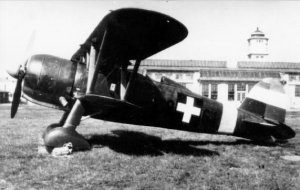
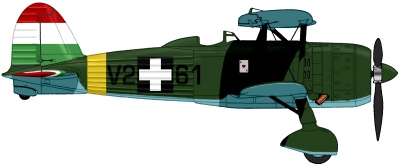
14-19 July 1941
Between the 14 and 19 July, the 1/3. vadászszázad flew several reconnaissance and escort sorties.
20 July 1941
Twelve Fiat CR.42s and one Arado Ar96 of the 1/3. vadászszázad moved 110km eastwards to Bar were the unit shared the airfield with a German short-range reconnaissance unit and a Slovakian Avia B-534 squadron, which already were stationed there.
22 July 1941
Százados László Tomor, squadron CO of the 1/3. vadászszázad took off from Bar airfield with four other CR.42s to reconnoitre the area between Braclav, Bersady, Tulchyn and Dzhurin. During this mission, they attacked and strafed enemy columns and armour. Ground fire was intense and only one Fiat escaped unscathed, because the aircraft lacked armour protection and thus were vulnerable to ground fire. Százados Tomor was wounded in five different places, and received the most punishment; nevertheless, he returned to base.
23 July 1941
The Fiat CR.42s of 1/3. vadászszázad moved to Sutysk.
24 July 1941
Six CR.42s of 1/3. vadászszázad performed reconnaissance and escort duty. Among other missions, they escorted four WM-21s, which were sent to bomb Ivangorod airfield. However, when they approached the target at 16:30, heavy anti-aircraft fire dispersed the attackers, which had to drop their bombs at random. The scattered ’Sólyoms’ returned to base individually, losing their fighter escort. Instead, the biplanes strafed the Soviet Flak positions with good results.
28 July 1941
In the morning, 1/3. vadászszázad moved forward to Annopol airfield along with I. közelfelderítö-század. The fighters were immediately thrown into combat flying bomber escort and strafing missions.
Six CR.42s of the unit escorted three Ca.135bis bombers from 3./II bombázószázad on an attack on Bersady. This was the first combat mission for the Caproni ’raj’ (three-aircraft formation). Along with nine Ju86K-2s, they formed the so-called ‘mixed bombing squadron’ commanded first by százados Béla Vitán, who was replaced a few days later by százados Lóránt Telbisz.
29 July 1941
A Hungarian CR.42 was spotted flying over Tul’chin airfield, where the Slovak 13th letka was located. Three Slovak pilots scrambled with their Avia B-534s to pursue the ‘intruder’, whose identity was well known to them. One of them, Ján Reznák (top Slovak ace of WWII with 32 victories), managed to catch up with the unsuspecting CR.42. The Slovak pilot, who at that time was not skilled and had no combat experience, started to fire from long range, and only slightly damaged the Hungarian machine. However, in the meantime, they approached the Hungarian airfield and the AA artillery opened up on the Slovak attacker, compelling Reznák to retreat.
The Hungarian command vehemently protested to the Germans, but the case eventually vanished in ‘red tape’. It however illustrated how tense the relationship actually was between the two Axis ‘allies’!
30 July 1941
In the early morning, CR.42s from the 1/3. vadászszázad performed cover for short-range reconnaissance aircraft.
In the afternoon, all ten serviceable fighters escorted six Ju86Ks of 4/I. bombázóosztály bombing Soviet troop and vehicle concentrations identified in the forest east of Yusefovka. Over the target, one of the Ju8gK-2s was hit by shrapnel, but it returned to base.
1 August 1941
A Hungarian Ju86K ’raj’ escorted by ten CR.42s targeted Soviet artillery positions near Savra. The mission was uneventful.
3 August 1941
CR.42s from the 1/3. vadászszázad scrambled to intercept Soviet fighters attacking ground targets. But they arrived too late and the Soviet aircraft had long gone.
4 August 1941
Two pairs of CR.42s from the 1/3. vadászszázad escorted reconnaissance aircraft to Pervomaysk and Savran. Other fighters covered friendly troops advancing in the Olviopol area.
5 August 1941
During the day, it was reported to the Hungarian headquarters that a multi-engined Soviet aircraft had landed in the village of Podvysokoye, possibly with the order to rescue some high-ranking officers or commissars of the surrounded Soviet army in the Uman pocket. Six CR.42s of the 1/3. vadászszázad took off and százados László Tomor lead the first section, while hadnagy János ‘Hanzi’ Pettendi led the second. Another pilot who took part in this mission was szakaszvezetö Lajos Göcsei. They circled around the village at 6000 feet, but they couldn’t locate the target. Tomor spotted a building, which looked like a command post; thus, he decided to investigate. He dived steeply, followed by the others. The antiaircraft batteries remained silent, reluctant to disclose their location too soon. As his Fiat zoomed downward, Tomor suddenly sighted a well-camouflaged three-engined machine standing next to a house at the village’s perimeter. A few jerks on the stick, slight adjustments, then he pressed the firing button. Now the defences opened up. However, it was too late. The tracers found their mark and the big transport went up in flames. All the Hungarian CR.42s sent at least one long burst into the burning aircraft. However, the antiaircraft fire was heavy and every one of the fighters received hits and only two being able to return to base. Two pilots were missing but luckily Göcsei soon rang and reported that his aileron cable had been damaged and he had made an emergency landing at Anapol (80km west of Rovno). However, there was no news from Pettendi, a famous sporting airman. Despite the ensuing aerial search and inquiries made through intelligence channels, no trace of him was ever found thus making him the squadrons first and only pilot killed in combat during this tour of duty.
8 August 1941
Few more sorties were flown before the unit moved to Pervomaysk on 8 August.
11 August 1941
At 04:30, a record number of five out of the six Caproni Ca.135bis took off and performed a successful bombing raid on Nikolayev. They also attacked a strategic bridge over the Bug River close to the city. The bombers were joined by their unusually strong fighter escort – comprising six CR.42s of the 1/3. vadászszázad and five Re.2000s of the 1/2. vadászszázad led by százados László Tomor – over Pervomaysk airfield. Loaded with captured Soviet 100kg bombs, the Capronis flew out over the Black Sea east of Odessa before making a wide circle to surprise the city’s defence by coming from the south-east. The leading aircraft, with flight leader főhadnagy István Szakonyi at the controls, released its bomb load on the central railway station from 3000m. The other bomber raj (flight) bombed the bridge.
The Hungarian encountered strong anti-aircraft fire. The starboard engine of B.517, the aircraft flown by főhadnagy Szakonyi, was hit by shrapnel, causing the aircraft to lose speed and lag behind the rest of the formation. The lone Caproni was then attacked by six I-16s but despite repeated attacks from various angles, the fighters couldn’t score a fatal hit. Moreover, the bomber’s two gunners claimed three of the attackers. Örmester János Bánkuti (radio operator) reported shooting down two and szakaszvezetö János Mester (flight engineer) one. One of the I-16s had positioned itself in the bomber’s blind spot as it closed in from behind for the kill but was jumped at the last minute by a CR.42, who promptly shot it down. Soon after this episode, the bomber reached friendly territory but because of the extensive damage sustained during the combat, the pilot decided to land at the larger Pervomaysk airfield. Once on firm ground, the exhausted crew counted 42 bullet holes in their aircraft yet none of the five crewmembers – which included a supernumerary, Staff alezredes Sándor András – was even lightly wounded.
Another second flight bomber was also attacked by three I-16s while leaving the target area. One of them was claimed as shot down by the radio operator. Soon afterwards, the lone Caproni was able to find sanctuary in clouds and escape the fighters’ further attention. A third Hungarian bomber escaped a trio of I-16s which were engaged by a pair of CR.42s. One of the I-16s was shot down and the survivors were forced to disengage.
Meantime, on their way from Nikolayev, the remaining Hungarian bombers were attacked by nine Soviet I-16s. They were immediately engaged by the escorting CR.42s and a wild mêlée developed, involving six Hungarian biplanes and nine Soviet monoplanes with the Re.2000s joining in. The Hungarian fighters flew above the bombers when they left the target area and when the Russian leader selected the first Caproni he was intercepted by szakaszvezetö Lajos Göcsei and hadnagy Albert Seres. A turning dogfight followed but the Hungarian CR.42s stayed behind the desperate Russian until Göcsei found himself in a favourable position. He sent a long burst into the fuselage of the I-16, flames leapt from the aircraft and it fell towards the ground like a spinning torch. Almost at the same time zászlós Miklós Kun had shot down another I-16 which just flew in front of his machine guns. When Tomor rejoined the bombers, he discovered a lone I-16 behind one of the Capronis. He dived on the enemy and shot it down in flames. At the same time, zászlós Márton Szönyi and zászlós Baranyai, who were escorting a crippled Caproni (főhadnagy Szakonyi’s Ca.135), encountered two I-16s and shot them down promptly. Seres, who flew back to search for the two fighters and the bomber, saw the two Soviet fighters hitting the deck. This was the 1/3. "Kőr Ász" vadászszázad first five claims during the Second World War and all CR.42s were hit but none were lost. The claimants were the squadron CO százados Tomor, zászlós Kun, zászlós Szönyi, zászlós Baranyai and szakaszvezetö Göcsei (the latter shared with hadnagy Seres).
1/2. Vadászszázad claimed three victories when szakaszvezetö Kálmán Gémes, százados László Gyenes and föhadnagy Tamás Móry claimed one each. However, Reggiane V.420 of főhadnagy Gyula Lasztóczy was missing (possibly shot down by flak) and this was the 1/2. vadászszázad first combat loss.
The Soviet 9 IAP-ChF claimed three enemy aircraft shot down near Nikolayev. However, two of its pilots, squadron CO Kapitan Aleksey Kolobkov, together with Leitenant Leonid Danchenko, were shot down in air combat in the Nikolayev area. Both were KIA.
12 August 1941
One flight of CR.42s from the 1/3. vadászszázad moved forward to the recently captured Voznesensk airfield.
The six other fighters, which stayed put, took off at around 06:00 to escort three Ju86Ks over Novaya Odessa, Sebino and Sukhoy Yelanets area, without finding any worthwhile target.
The day’s final combat mission, performed by three CR.42s and an identical number of Ju86Ks started at around 14:00. The bombers released part of their payload upon Soviet columns caught on the road between Novaya Odessa and Konstantinovka, as well as in the Ingulka Valley. In addition, the Hungarians targeted successfully a large warship moored in Nikolayev harbour. Finally, one bomber managed to score direct hits on a military bridge spanning the river Bug, between Trichaty and Pisky, just north of Nikolayev.
Summarising its month at the front, the 1/3. "Kőr Ász" vadászszázad reported 35 combat missions in 151 sorties, claimed five aerial victories and lost one pilot, with another wounded and nine others damaged.
13 August 1941
In the early morning, a He 46E (F.307) of I. közelfelderítö-század performed a reconnaissance sortie over the Bug and Ingul estuaries and also the area around Nikolayev, including traffic on the road between Novaya Odessa and Nikolayev. The Hungarian crew photographed the airfield located south of Mala Korechyn, were several Soviet aircraft were spotted. But the most important discovery was a Soviet gunboat at Pesky, which was firing at ground troops with great effect. As soon as this information had been relayed to headquarters, another He 46 (F.316) of the same unit and manned by főhadnagy László Csura (observer) and szakaszvezetö Jósef Tóth (pilot), was sent out to neutralise the treat. It was escorted by a CR.42 flown by zászlós Ferenc Ölveczky of 1/3. vadászszázad. In order to surprise the target, the attacking pair closed in from Trihoty, south-east of the target. On sighting the gunboat, the He 46 descended to 300m and dropped its entire load of a dozen 10kg bombs in a single salvo. The crew observed direct hits on the vessel but it was not put out of action. Both aircraft then sprayed the deck with machine-gun fire, prompting a response from the ship’s anti-aircraft defence, which hit the low-flying He 46 in several places. Due to the damage, the pilot decided to land at Voznesensk airfield, where the landing gear collapsed. The crew escaped unhurt.
The gun-boat was reportedly forced back to the Black Sea.
Five Ca.135bis bombers, escorted by three CR.42s, performed a reconnaissance and bombing mission over the Novaya Odessa-Nikolayev-Ingul Valley area. Despite heavy anti-aircraft fire en route, they returned without loss or damage.
14 August 1941
Between 09:00-09:40, a three-Ca.135bis ‘raj’, escorted by a similar number of CR.42s, attacked targets of opportunity around Novaya Odessa. Only one bomber found a target worthy of its bombs.
16 August 1941
A three-Ca.135bis ‘raj’ of 4. önálló bombázószázad, escorted by a similar number of CR.42s, targeted Ingulka village. However, only one bomber found a target worthy of its bombs.
19 August 1941
In the early morning, the 1/3. vadászszázad moved to Krivoy Rog.
26 August 1941
During the next days the vadászszázad flew several sorties over the industrial centre of Dniepropetrovsk. On this day hadnagy Albert Seres’ section flew a sortie over the city and was engaged in combat with Soviet I-16s. Seres and zászlós Szőnyi claimed two I-16s each while zászlós Baranyai claimed a fifth I-16. Baranyai’s aircraft was damaged during this combat and he was wounded himself but managed to bring back his fighter. He was patched up by the medics and flew again the next day.
It seems that they had been in combat with 88 IAP, which misidentified them as Ar 197s. The Soviet pilots claimed one victory.
27 August 1941
During a second patrol over Dniepropetrovsk, hadnagy Seres and zászlós Baranyai claimed two I-16s.
Zászlós Szönyi was rammed by starshii leitenant P. N. Maltsev of 88 IAP (his second and last claim) in a ‘taran’ ramming attack over Dniepropetrovsk and taken POW during the day. It is possible that he claimed a victory before he was shot down but there aren’t any witnesses to this claim. Maltsev managed to land his damaged I-16.
2 September 1941
5 September 1941
6-17 September 1941
20 September 1941
22 September 1941
10 October 1941
3 November 1941
15 November 1941
18 November 1941
26 November 1941
The CR.42s of the 1/3. vadászszázad was relegated to training role in which they were shortly to be joined by those of the remainder of the 1./II Osztály and of the 2./II Osztály.
Hungarian claims with the Fiat CR.42:
Föhadnagy Ujszászy’s section was first over Dniepropetrovsk. The section surprised Soviet fighters taking off. During the combat Ujszászy and törzsörmester (Staff Sergeant) Szobránci claimed two I-17s (LaGG-3 or MiG-3) each while zászlós Szénási claimed a fifth. A sixth aircraft was claimed as a probable. In the evening, the German intelligence confirmed the destruction of at least 5, possibly 6 aircraft.
Százados Tomor strafed Soviet ground forces at the Dniepropetrovsk bridgehead together with eight more pilots with great success.
This was repeated three days later with even more success against soviet forces on the Zaporoshye Island, which was the subject of bitter fighting.
During the next twelve days, six bomber escort missions were flown in the same area.
Százados Tomor led five fighters to help an encircled German regiment east of Nikopol. They strafed the enemy and while they were doing so, the Germans launched a counterattack and broke out of the ring.
Five Soviet bombers attacked the airfield the vadászszázad was operating from (during a soccer match!). The unit didn’t suffer any losses but the Reconnaissance vadászszázad, which they shared airfield with, had two men killed and 15 wounded.
The reconnaissance, escort and patrol missions continued and, on this day, the vadászszázad moved to Dniepropetrovsk. One section was transferred to Golubovka and the other to Losovaya. However, the front moved so rapidly eastward that it was not possible to fly sorties from their bases.
The fighter, bomber and reconnaissance vadászszázads and the mobile workshop were ordered to assemble at Dnieprodshershinsk
Few more missions were flown and on 15 November the unit was told to prepare themselves for the return to Hungary. The Fiat CR.42s - and indeed the Ju 86s and He 46s - were not considered suitable for the Russian winter. No combat aircraft of the MKHL saw service in Russia between December 1941 and May 1942.
The vadászszázad left the front but they were forced to land at Vinnitsa due to bad weather and they were grounded there for eight days.
The unit crossed the Carpathians and set course for their home base at Mátyösfáld.
The 1/3. vadászszázad claimed 17 and 1 probable victories during 114 missions and 447 individual combat sorties. They lost two pilots and two aircraft. Hadnagy Pettendi was killed in action and zászlós Szönyi was taken POW.

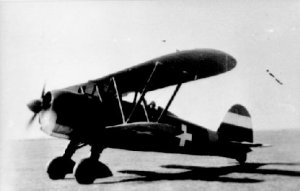
A few CR.42s served with a few fighter units at home until 1942 but they were soon pulled out of front-line service and used as advanced trainers. There were plans to use a number of them as night fighters, but they were unsuitable for the role since they lacked radios.
In early 1944, a ground attack squadron was formed with the surviving CR.42s. Bomb racks were installed under the wings, but the squadron never saw active service.
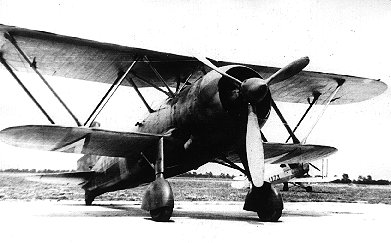
Image kindly via Dénes Bernád.
| Kill no. | Date | Number | Type | Result | Pilot | Plane type | Serial no. | Locality | Unit |
| 1 | 27/06/41 | 1 | R-5 | Destroyed | Árpád Kertész | Fiat CR.42 | Stanislav area | 2/3. vadászszázad | |
| 2 | 11/07/41 | 1 | I-16 | Destroyed | Gyõzõ Vámos | Fiat CR.42 | Smotricz area | 2/3. vadászszázad | |
| 11/07/41 | 1 | I-16 | Shared damaged | All the pilots of the section | Fiat CR.42 | Smotricz area | 2/3. vadászszázad | ||
| 3 | 12/07/41 | 1 | I-16 | Destroyed | Aladár Szobránczy | Fiat CR.42 | W Zwanczyk | 2/3. vadászszázad | |
| 4 | 12/07/41 | 1 | I-16 (a) | Destroyed | Gyõzõ Vámos | Fiat CR.42 | V-265 | W Zwanczyk | 2/3. vadászszázad |
| 5 | 12/07/41 | 1 | I-16 | Destroyed | László Pottyondy | Fiat CR.42 | W Zwanczyk | 2/3. vadászszázad | |
| 6 | 12/07/41 | 1 | I-16 | Destroyed | János Balogh | Fiat CR.42 | W Zwanczyk | 2/3. vadászszázad | |
| 7 | 12/07/41 | 1 | I-16 | Destroyed | Péter Soós | Fiat CR.42 | W Zwanczyk | 2/3. vadászszázad | |
| 05/08/41 | 1 | Soviet a/c | Sh. destroyed on the ground | All the pilot of the unit | Fiat CR.42 | Podvishikoye | 1/3. vadászszázad | ||
| 8 | 11/08/41 | 1 | I-16 | Destroyed | László Tomor | Fiat CR.42 | Nikolayev area | 1/3. vadászszázad | |
| 9 | 11/08/41 | 1/2 | I-16 | Shared destroyed | Lajos Göcsei | Fiat CR.42 | Nikolayev area | 1/3. vadászszázad | |
| 9 | 11/08/41 | 1/2 | I-16 | Shared destroyed | Albert Seres | Fiat CR.42 | Nikolayev area | 1/3. vadászszázad | |
| 10 | 11/08/41 | 1 | I-16 | Destroyed | Miklós Kun | Fiat CR.42 | Nikolayev area | 1/3. vadászszázad | |
| 11 | 11/08/41 | 1 | I-16 | Destroyed | Márton Szõnyi | Fiat CR.42 | Nikolayev area | 1/3. vadászszázad | |
| 12 | 11/08/41 | 1 | I-16 | Destroyed | Károly Baranyai | Fiat CR.42 | Nikolayev area | 1/3. vadászszázad | |
| 13 | 26/08/41 | 1 | I-16 | Destroyed | Albert Seres | Fiat CR.42 | V-202 | Dniepropetrovsk area | 1/3. vadászszázad |
| 14 | 26/08/41 | 1 | I-16 | Destroyed | Albert Seres | Fiat CR.42 | V-202 | Dniepropetrovsk area | 1/3. vadászszázad |
| 15 | 26/08/41 | 1 | I-16 | Destroyed | Márton Szõnyi | Fiat CR.42 | V-203 | Dniepropetrovsk area | 1/3. vadászszázad |
| 16 | 26/08/41 | 1 | I-16 | Destroyed | Márton Szõnyi | Fiat CR.42 | V-203 | Dniepropetrovsk area | 1/3. vadászszázad |
| 17 | 26/08/41 | 1 | I-16 | Destroyed | Károly Baranyai | Fiat CR.42 | Dniepropetrovsk area | 1/3. vadászszázad | |
| 18 | 27/08/41 | 1 | I-17 | Destroyed | György Ujszászy | Fiat CR.42 | Dniepropetrovsk area | 1/3. vadászszázad | |
| 19 | 27/08/41 | 1 | I-17 | Destroyed | György Ujszászy | Fiat CR.42 | Dniepropetrovsk area | 1/3. vadászszázad | |
| 20 | 27/08/41 | 1 | I-17 | Destroyed | Sándor Szobránci | Fiat CR.42 | Dniepropetrovsk area | 1/3. vadászszázad | |
| 21 | 27/08/41 | 1 | I-17 | Destroyed | Sándor Szobránci | Fiat CR.42 | Dniepropetrovsk area | 1/3. vadászszázad | |
| 22 | 27/08/41 | 1 | I-17 | Destroyed | Ferenc Szénási | Fiat CR.42 | Dniepropetrovsk area | 1/3. vadászszázad | |
| 27/08/41 | 1 | I-17 | Probably destroyed | Fiat CR.42 | Dniepropetrovsk area | 1/3. vadászszázad | |||
| 23 | 27/08/41 | 1 | I-16 | Destroyed | Albert Seres | Fiat CR.42 | V-202 | Dniepropetrovsk area | 1/3. vadászszázad |
| 24 | 27/08/41 | 1 | I-16 | Destroyed | Károly Baranyai | Fiat CR.42 | Dniepropetrovsk area | 1/3. vadászszázad | |
| 27/08/41 | 1 | I-17 | Probably destroyed | Márton Szönyi | Fiat CR.42 | V-203 | Western Ukraine | 1/3. vadászszázad |
TOTAL: 24 destroyed, 2 probably destroyed, 1 damaged, 1 destroyed on the ground.
(a) Claimed after a collision.
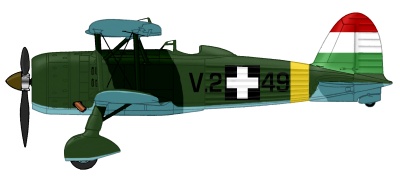
Sources:
Air Enthusiast/Twenty
A magyar királyi 1. honvéd éjjeli vadász repülõszázad Magyar Repüléstörténeti Társaság Konferencia Közleményei 1999 - Csaba Becze
A magyar légiero teljesítményei a Kárpátoktól a Dnyeperig - Béla Orosz, 1942 Budapest kindly provided by Csaba Becze
Biplane Against The Red Bear - Julius R. Gaal, 1974 Air Combat Spring/1974 kindly provided by Santiago Flores
Harcok az orosz égen Budapest - László Tomor, 1942 kindly provided by Csaba Becze
Elfelejtett Hősök - Csaba Becze, 2006 Puedlo Kiadó, ISBN 963-9673-064
“Kőr ász” Egy vadászrepülő század története 1936-1941 - Csaba Becze, 2007 Puedlo Kiadó, ISBN 978-9639673854
The Fiat CR.42 - Gianni Cattaneo, 1971
Additional information kindly provided by Csaba Stenge
Images from Laszlo Jávor, Ferenc Zsák, and Peter Mujzer via
Tadeusz P. Dobrowiecki
